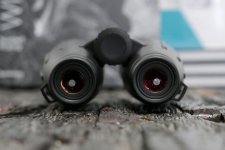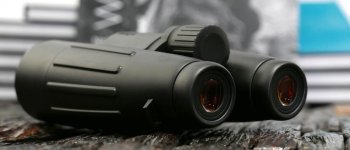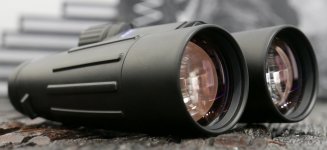Hi,
first of all, for getting optimal performance with a pair of bins in a dark environment you might want to get the diameter of your dark adapted pupils measured. Your eye doctor can do this - although they tend to often get results for the not fully dark adapted eye as that is not trivial to measure and takes time between tries. In your case it probably won't hurt as you are looking for birds and not stars and thus your eyes are probably not going to be fully dark adapted anyways most of the time.
Also people have been successful standing in front of a mirror with a ruler in front of their eyes and a camera with flash...
After you have got your dark adapted pupil size, you know what exit pupil to aim for - if you are not that young any more, 4 or 5mm might be all you need.
When comparing current bins with the same exit pupil and different magnifications in low light, higher magnification helps, provided you can still hold it steady ok. That is why the twilight factor contains magnification too. So if you are used to 10x and can hold those well, by all means stick to that magnification.
As for coatings, you of course want good ones with high transmission in general - since you are aiming for conditions which will use a lot of scotopic vision and rods are most sensitive at around 500nm in the green/blue region, getting a pair with its transmission peak in the vicinity might be a good idea. So Zeiss with their green/blue signature rendition probably does know a thing about low light bins and there is a reason why the 54mm HT models are quite popular in the hunting community.
Joachim
first of all, for getting optimal performance with a pair of bins in a dark environment you might want to get the diameter of your dark adapted pupils measured. Your eye doctor can do this - although they tend to often get results for the not fully dark adapted eye as that is not trivial to measure and takes time between tries. In your case it probably won't hurt as you are looking for birds and not stars and thus your eyes are probably not going to be fully dark adapted anyways most of the time.
Also people have been successful standing in front of a mirror with a ruler in front of their eyes and a camera with flash...
After you have got your dark adapted pupil size, you know what exit pupil to aim for - if you are not that young any more, 4 or 5mm might be all you need.
When comparing current bins with the same exit pupil and different magnifications in low light, higher magnification helps, provided you can still hold it steady ok. That is why the twilight factor contains magnification too. So if you are used to 10x and can hold those well, by all means stick to that magnification.
As for coatings, you of course want good ones with high transmission in general - since you are aiming for conditions which will use a lot of scotopic vision and rods are most sensitive at around 500nm in the green/blue region, getting a pair with its transmission peak in the vicinity might be a good idea. So Zeiss with their green/blue signature rendition probably does know a thing about low light bins and there is a reason why the 54mm HT models are quite popular in the hunting community.
Joachim
Last edited:







